Before the lesson:
• Use a sharp point or an awl to make a hole in the bottom of the plastic cup. The hole should be off-center, and just large enough for the skewer to fit through without becoming loose.
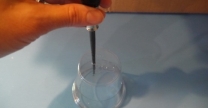
Engage:
1. Students participate in the What Do You Know? activity to discuss what they know about the movements of the Sun and Earth.
2. Post one the following four signs in each corner of the classroom.
- The Sun rises in the east and sets in the west.
- The Sun rises in the west and sets in the east?
- The Sun does not rise or set.
- The Earth rises and sets.
3. Read each sign aloud. Then direct students to stand next to the sign that they agree with.
4. After students have moved to the sign they believe to be true, they must discuss the facts that support their position.
5. Next ask each group to explain their position and the facts that support it.
6. Explain that students will conduct a series of investigations about the movement of the Earth to find evidence that supports their thinking. After students have completed the investigations they will repeat the activity again to see if they still think the same way.
Explore: (This activity must begin in the morning on a sunny day.)
1. Explain to students that they will create a record to investigate how the Earth moves in relation to the Sun. Take students outside so students can monitor and measure the changes they observe.
2. Organize students into groups of 2 or 3. Give each group a piece of poster board, a small piece of clay, and a dowel or pencil.
- Students place the poster board on a hard, flat surface free of any shadows.
- Place one end of the dowel in the middle of the poster board so that the dowel is perpendicular to the ground. Then attach the other end of the dowel to the poster board with a piece of clay.
3. If the day is windy than tape the poster board to the surface.
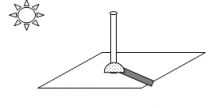
4. Students may use other methods for constructing their sun dial.
- Push a brad through a piece of paper and attach the paper to the ground.
- Push a large dowel into the ground between a sidewalk and an area of grass. Place a piece of poster board on the sidewalk making sure the dowel’s shadow will appear on the board.
- Place a large dowel into a pot of gravel. Place the pot on a large concrete surface to make a large sundial the class can monitor together.
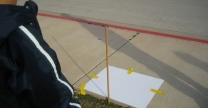
5. Once secured to the ground, students should locate the shadow of the pencil/dowel.
- Trace the line of the shadow and write the time next to the line.
- Measure and record the length of the shadow.
- Visit the site every hour throughout the day to trace the shadow and to record the time and the length.
- Use a protractor to measure each angle.
6. At the end of the day, remove the poster board and take back to the classroom to discuss.
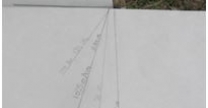
Explain:
1. In the classroom ask and discuss:
- About how much per hour did the sun’s shadow move? Students use protractors to measure the angle at each interval and may notice a consistent angle between each hour.
- Can you observe a pattern? Students should discuss their observations about how the shadows have changed.
- Which direction did the shadow move? clockwise
- What do you notice about the length of the shadow throughout the day? With more direct sunlight the sun is overhead and cannot create a long shadow. When the sun is at an angle, the shadow is longer.
- Why does the shadow move? Is the earth or the sun moving? Discuss sayings such as “The sun rises in the east and sets in the west.” Students may get a sense that the earth is rotating. Based on prior knowledge, students may say that all the planets move around the Sun.
- What do you predict would happen if we could continue tracing the shadow until the next day? The sundial would be complete all the way around the pencil/dowel.
- What do we call what we have made? a sundial
- What do we call one complete turn of the earth? rotation
- How long will it take the earth to make one rotation? 24 hours.
7. Discuss whether the shadows would fall in the same places tomorrow.
8. View one of the following resources to see how Earth’s rotation creates day and night.
Elaborate:
1. Explain that students will create a model to demonstrate how the Earth moves.
2. Give each group a plastic cup with a small hole punched in the bottom.
3. Students place a skewer inside the hole.

4. Tilt the skewer at an angle, and use a protractor to check the angle of the skewer’s tilt. It should be 23.5 degrees to model the Earth’s tilt.
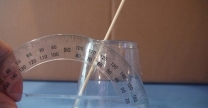
5. Lay out a 6-cm piece of tape and stick a 2-cm piece to its center (sticky sides together).
6. Use the modified tape to hold the straw against the side of the cup, yet still allowing the straw to rotate in the hole.
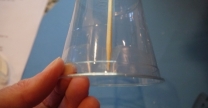
7. Place a rubber band around the center of the Styrofoam ball.
8. Press the ball onto the end of the skewer. It will show the same tilt as the skewer.
9. Place a sticky dot above the equator to represent where the student lives. Students may also use a Sharpie pen to draw in features such as the North and South Poles.

10. Next students place a lamp so that it is pointing towards the Earth model.
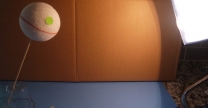
11. Students use the skewer to rotate the Earth, showing the movement between day and night. Ask:
- Which direction should you rotate the Earth? Since the sun’s light moved clockwise, the Earth must be rotating counterclockwise.
12. Compare the model to the sundials students made earlier. Ask and discuss:
- For what fraction of the day is the dot in the light? The dot is in light about half of its rotation, but students will notice that the amount of light varies.
- For what fraction of the day is the North Pole in the light?
- How is the light striking the equator? The dot? The North and South Poles?
13. Draw the United States on one of the Styrofoam balls. Place a dot on the east and west coasts. Ask and discuss:
- Does each coast of the United States receive the same amount of light at the same time? Students will notice that the east coast receives light before the west coast.
13. Show a time zone chart and identify the time zones in the United States. Students can connect the different time zones with the difference in when each area of the country receives light.
Evaluate:
1. Conduct the What Do You Know? Activity again.
2. Discuss whether students changed their minds and the evidence students used to make their decisions.
3. Students complete the Day and Night Results page.

